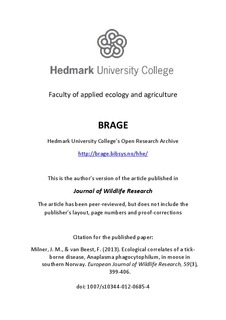Ecological correlates of a tick-borne disease, Anaplasma phagocytophilum, in moose in southern Norway
Journal article, Peer reviewed

Åpne
Permanent lenke
http://hdl.handle.net/11250/134560Utgivelsesdato
2013Metadata
Vis full innførselSamlinger
Originalversjon
Milner, J. M., & van Beest, F. (2013). Ecological correlates of a tick-borne disease, Anaplasma phagocytophilum, in moose in southern Norway. European Journal of Wildlife Research, 59(3), 399-406. doi: 10.1007/s10344-012-0685-4 10.1007/s10344-012-0685-4Sammendrag
As the distribution and abundance of ticks increase, so do the risks of tick-borne diseases. Anaplasma phagocytophilum, transmitted by Ixodes spp. ticks, is a widespread tick-borne infection causing tick-borne fever (TBF) in domestic ruminants and human granulocytic anaplasmosis. However, the role of wildlife in its epidemiology is poorly understood. Evidence of infection has been detected in wild cervids, but the pathogenicity and ecological consequences are unknown. We conducted a serological study of moose (Alces alces) in two populations in southern Norway, one where TBF was endemic (Telemark) and the other where sheep ticks (Ixodes ricinus) were essentially absent (Hedmark). Seroprevalence to A. phagocytophilum antibodies was 79 and 0 %, respectively. In Telemark, seroprevalence was significantly higher among females that calved successfully (85 %) than among others (50 %). Body mass and winter mass change were unrelated to serostatus. Relative abundance of questing ticks in Telemark was highest in deciduous forest and lowest in mature coniferous forest and higher at easterly aspects and altitudes below 350 m. Habitat factors associated with high tick abundance were risk factors for seropositivity among moose. Our findings were consistent with anaplasmosis causing a persistent subclinical infection in moose without population-level effects. Further work is needed to establish the importance of moose as a reservoir for the disease in sympatric domestic livestock.
Beskrivelse
This is the postprint version of the article published in European Journal of Wildlife Research. The published version can be located at www.springerlink.com